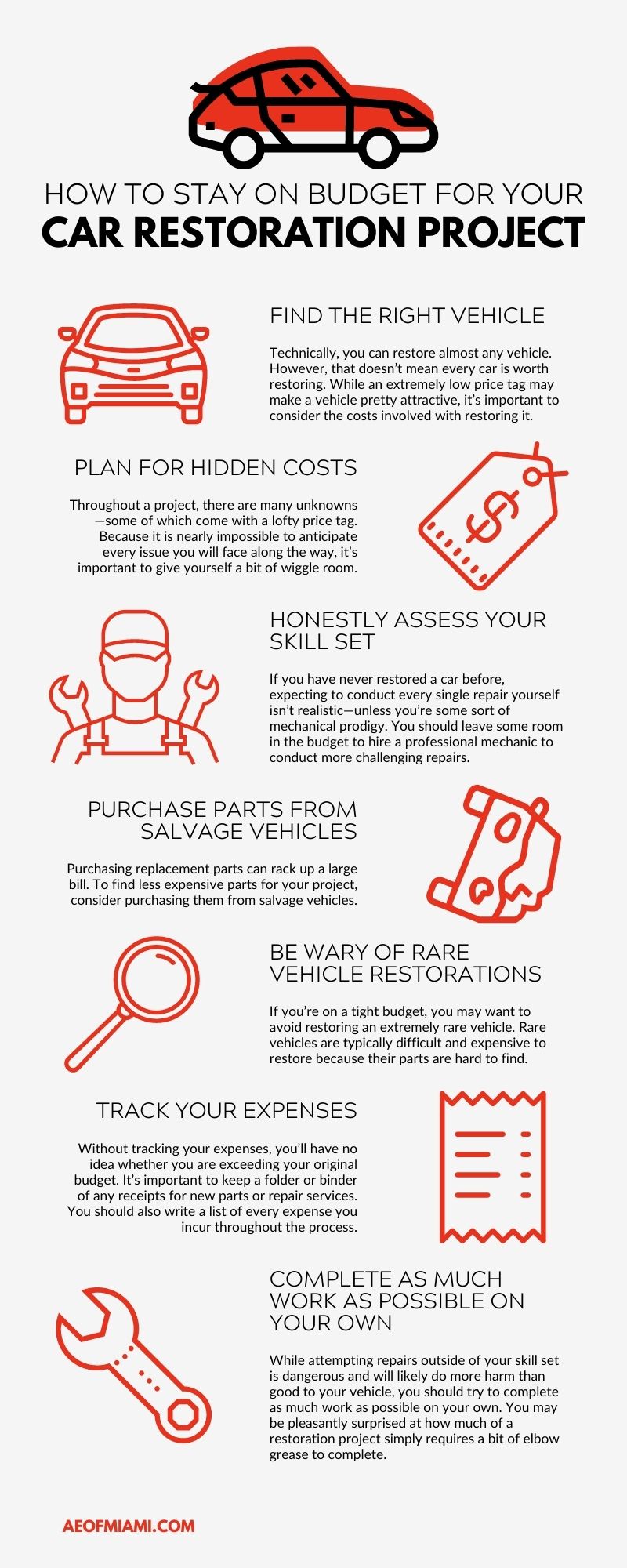
Unless you have unlimited funds, it is important to craft a budget before starting a car restoration venture to ensure that your project is financially feasible. That being said, creating a budget for your car restoration project is one thing. Sticking to it is another. Often, unexpected issues and surprisingly high costs can cause one’s car budget to shoot through the roof. To keep your finances stable throughout the process, read this guide on how to stay on budget for your car restoration project.
Technically, you can restore almost any vehicle. However, that doesn’t mean every car is worth restoring. If the vehicle is in incredibly poor condition, you may want to consider finding one in better shape. While an extremely low price tag may make a vehicle pretty attractive, it’s important to consider the costs involved with restoring it.
Vehicles with extensive rust, water damage, missing components, or other issues aren’t very practical from a financial standpoint. Creating a budget for cars with lots of damage can be challenging, as unexpected problems may pop up along the way. To create a realistic budget and stick to it, you may want to consider choosing a project vehicle in better condition. It won’t require quite as much time and money to become roadworthy.
When creating the budget for your car restoration project, you should leave a significant amount of room for hidden costs. Throughout a project, there are many unknowns—some of which come with a lofty price tag. Because it is nearly impossible to anticipate every issue you will face along the way, it’s important to give yourself a bit of wiggle room.
Depending on the size of your project, you should include a cushion of a few hundred or a few thousand dollars to go toward any costly surprises. You can reduce your chances of abandoning or significantly delaying the completion of your restoration because you ran out of funds halfway through.
To stay on-budget when embarking on a car restoration project, it is important to have a good understanding of your skill set with regard to repairing cars. If you have never restored a car before, expecting to conduct every single repair yourself isn’t realistic—unless you’re some sort of mechanical prodigy.
You should leave some room in the budget to hire a professional mechanic to conduct more challenging repairs. Overestimating one’s skills is one of the main reasons why many ambitious people end up spending way more than they expected.
Purchasing replacement parts can rack up a large bill. To find less expensive parts for your project, consider purchasing them from salvage vehicles.
Purchasing parts from a salvage vehicle is typically far cheaper than purchasing a brand new vehicle component. Plus, many salvage vehicles have components in great condition, which means you can get a perfectly good part for a fraction of the cost. To find salvage parts for your project, consider scouring a salvage yard or junkyard or purchasing them online from a trustworthy and reliable seller.
If you’re on a tight budget, you may want to avoid restoring an extremely rare vehicle. Rare vehicles are typically difficult and expensive to restore because their parts are hard to find.
Even if you find a rare vehicle for an amazingly low price, the thrill of getting a good deal probably won’t last when you realize you need to buy a ton of highly expensive parts in order to get it in working condition. And that’s only if you can even find the parts you need in the first place. If you have the funds to start a rare vehicle restoration project, make sure to do lots of research on where to buy the parts that you need. You should also check how much they will cost so that you can lock down a realistic budget.
To stay on budget for your car restoration project, you will need to keep track of how much you’re spending. Without tracking your expenses, you’ll have no idea whether you are exceeding your original budget. It’s important to keep a folder or binder of any receipts for new parts or repair services. You should also write a list of every expense you incur throughout the process. If you notice that you’re on track to exceed your budget, it’s time to stop and reassess your plans. If you’re repairing a salvage title vehicle, having the receipts for any replacement parts will also be useful when applying for a rebranded title.
While attempting repairs outside of your skill set is dangerous and will likely do more harm than good to your vehicle, you should try to complete as much work as possible on your own. You may be pleasantly surprised at how much of a restoration project simply requires a bit of elbow grease to complete.
For example, a significant part of the work in any car restoration project boils down to cleaning the car. While you don’t need a significant amount of skill to thoroughly clean the internal and external components of a vehicle, doing so can be extremely time consuming and will likely cost you a pretty penny if you outsource the job to someone else. You should consider rolling up your sleeves and thoroughly cleaning the various components of your vehicle yourself. To do so effectively, you may need to remove each part and clean it individually, so make sure to remember where everything goes and take pictures throughout the process.
Looking for the perfect vehicle for your restoration project? AE of Miami can help you find an amazing car at an incredible price. Plus, all of our listings provide full transparency regarding the car’s condition, so you know exactly what you’re getting. To find the right vehicle for your project, shop our extensive collection of repairable salvage cars today.